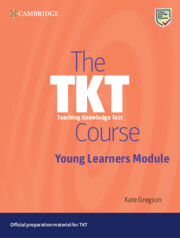Book contents
- Frontmatter
- Acknowledgements
- Contents
- Introduction
- Part 1 Knowledge of young learners and principles of teaching English to young learners
- Part 2 Planning and preparing young learner lessons
- Part 3 Teaching young learners
- Part 4 Assessing young learner learning in the classroom
- Follow-up activities: Answer keys and commentaries
- List of terms found in the TKT Glossary
- Glossary of TKT: Young Learners terms
- Test tips for TKT: Young Learners
- Teaching knowledge test young learners: Practice test
- Sample test answer sheet for TKT: YL practice test
- Answer key for TKT: YL practice test
Unit 10 - Managing learning: How can I manage children in class?
Published online by Cambridge University Press: 14 March 2024
- Frontmatter
- Acknowledgements
- Contents
- Introduction
- Part 1 Knowledge of young learners and principles of teaching English to young learners
- Part 2 Planning and preparing young learner lessons
- Part 3 Teaching young learners
- Part 4 Assessing young learner learning in the classroom
- Follow-up activities: Answer keys and commentaries
- List of terms found in the TKT Glossary
- Glossary of TKT: Young Learners terms
- Test tips for TKT: Young Learners
- Teaching knowledge test young learners: Practice test
- Sample test answer sheet for TKT: YL practice test
- Answer key for TKT: YL practice test
Summary
LEARNING OUTCOMES
By the end of this unit, you will…
KNOWLEDGE: know about different areas of classroom management
SKILLS: be able to select appropriate classroom management strategies for use in different classroom situations or contexts
■ Starter Question
Before you begin this unit, read the starter question and make some notes. Then read the commentary and compare it to your notes.
What does the term ‘classroom management’ mean to you?
COMMENTARY
‘Classroom management’ is an extremely broad area and covers all teacher skills and strategies which are done in the classroom to ensure as much learning happens as is possible. It is a practical classroom-based aspect of teaching and one which can give rise to many a teacher concern, when not handled appropriately. The TKT Glossary defines classroom management as follows:
‘The things teachers do to organise the classroom, the learning and the learners, such as organising seating arrangements, organising different types of activities and managing interaction patterns’ (p. 7).
Most teachers aim for a classroom where their learners are engaged and productive, and where they feel secure and confident to make every effort to learn. In such a positive learning environment, learners will achieve to the best of their ability and the teacher will also be positive and motivated. However, the well-developed organisational skills and confidence the teacher needs to achieve this can take time and effort to acquire.
■ Key concepts
Reflect on the key concept question. Brainstorm your ideas, then expand your notes as you read.
How can teachers develop a positive classroom atmosphere to promote learning? Note up to three points.
COMMENTARY
As we can infer from the definition on the previous page, there are several areas of classroom management teachers need to be aware of and develop in order to create a classroom where learners are motivated, respected, confident and willing to learn. We can break these down into six main areas:
1. Organising the classroom
2. Organising the learners
3. Organising learning
4. Managing time
5. Developing a respectful relationship with learners
6. Interacting with learners
- Type
- Chapter
- Information
- The TKT Course Young Learners Module , pp. 103 - 113Publisher: Cambridge University PressPrint publication year: 2024

